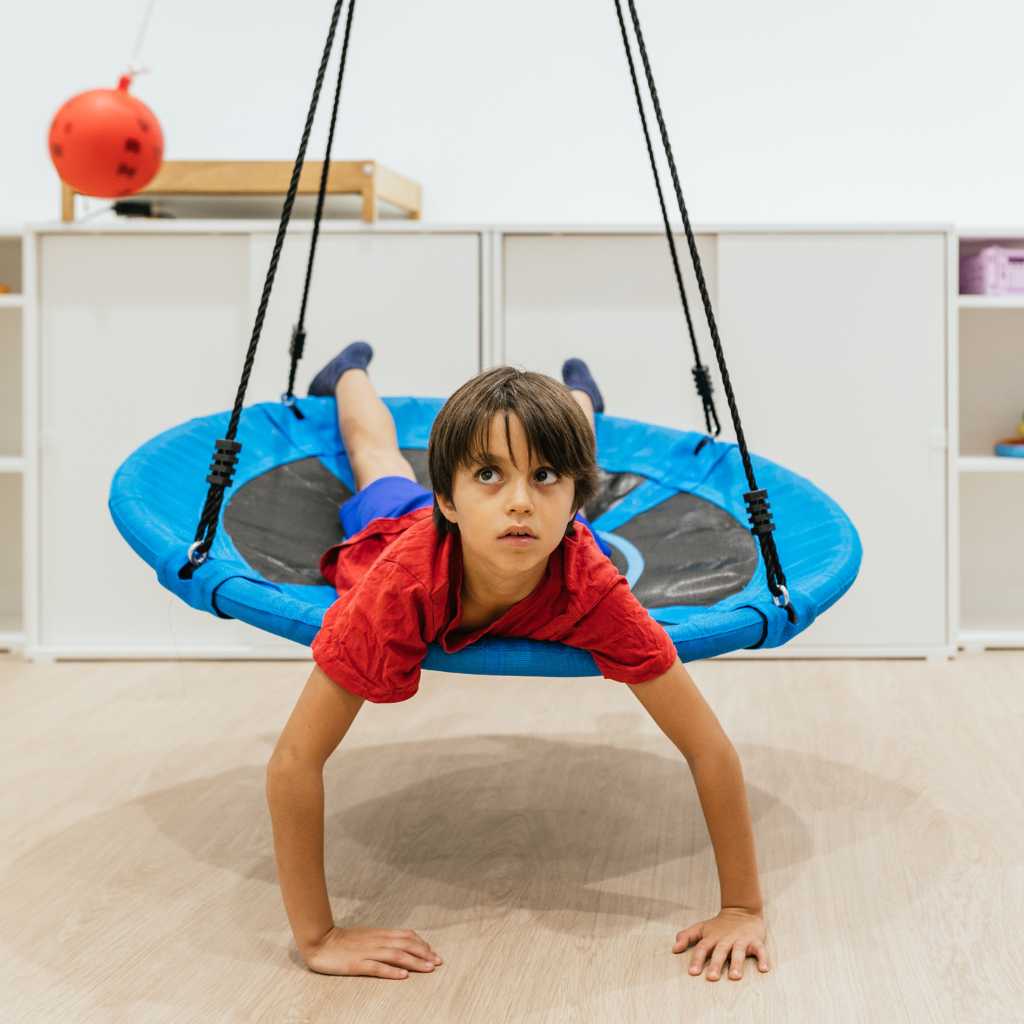Tabla de contenidos
How does autism affect a person’s window of tolerance?
When you’re supporting someone on the autism spectrum, your child, a sibling, a student, or even yourself, it’s easy to notice how quickly overwhelm can show up. One moment things seem fine; the next, a sound, a surprise change, or a burst of sensory input sends the whole day spiraling. What’s happening beneath the surface isn’t “misbehavior” or “overreaction.” It’s the nervous system hitting its limit.
The window of tolerance is a conducive framework that explains how our bodies and brains navigate stress, sensory input, emotions, and engagement with the world. For individuals with autism in particular, this window tends to be narrower, meaning it takes less to push them into overwhelm. Understanding that can completely shift how we support them with empathy and effectiveness.
But how autism affects a person’s window of tolerance isn’t always obvious. In simple terms, autism influences how the nervous system interprets both internal and external information; sensory input, emotions, transitions, communication demands, and unpredictability. These differences often make it more challenging to stay within that optimal zone where learning, communication, and connection are easiest. Once you understand this dynamic, it becomes much clearer why colapsos de autismo, shutdowns, or withdrawal happen, not as choices, but as nervous system responses.
En este blog de ABA Centers of Florida, we’ll explore the window of tolerance, why it matters in autism, what current research says, and how families can help widen and support it using practical strategies, including ABA therapy and early intervention services. Let’s dive in.
What Is the Window of Tolerance?
The term “Window of Tolerance” (WoT), initially introduced by psychiatrist Dr. Daniel Siegel, refers to the zone of arousal in which a person can function at their best, thinking clearly, connecting emotionally, communicating, and adapting to what’s happening around them. Within this window, the nervous system feels safe enough for engagement.
When we move above this window, we shift into hyperarousal, which may look like:
- Panic
- Fight-or-flight responses
- Intense anxiety
- Irritabilidad
- Meltdowns
When we fall below the window, we enter hypoarousal, which can involve:
- Shutdown
- Withdrawal
- Loss of words
- Slowed movement or thinking
- Dissociation-like responses
Frontiers in Behavioral Neuroscience describes these states as automatic shifts in autonomic functioning; moments when the brain prioritizes survival over social connection or reasoning. For individuals with autism, these shifts happen more quickly due to differences in sensory processing, interoception, and emotional regulation.
Autism and the Narrowed Window of Tolerance
Studies strongly support the idea that individuals with autism often have a narrower window of tolerance, making them more vulnerable to sensory or emotional overload. This narrowing links to:
- Sensory Processing Differences
People with autism often experience sensory input more intensely; sounds may be louder, lights brighter, and textures more irritating. Stimuli can rapidly push the nervous system toward overwhelm.

- Interoception Variability
Interoception refers to the ability to sense internal bodily cues like hunger, temperature, or emotional states. When interoception is irregular or muted, individuals may struggle to notice early signs of dysregulation, jumping straight to shutdown or meltdown.
Un King’s College London study showed that parents who learned about these sensory–interoceptive differences and about the window of tolerance reported improved understanding of why their children with autism struggled in specific environments. This understanding reduced frustration and improved support at home and in treatment settings.
- Emotional Dysregulation
Research published in Frontiers in Psychology. explains emotional dysregulation (ED) as difficulty staying within the window of tolerance, particularly under stress. ED is highly prevalent in autism and contributes significantly to meltdowns or withdrawal.
- Predictability Needs
Unexpected changes and transitions are known to be significant triggers in autism. The narrower the WoT, the harder it is to adapt when the environment shifts suddenly.
By combining these factors, it becomes clear why even minor stressors can overwhelm the nervous system of an individual with autism.
Window of Tolerance and Autism: What the Research Says
Emerging research provides meaningful insights into how the window of tolerance and autism intersect:

Polyvagal Foundations
Researchers have found a connection between the WoT and the Polyvagal Theory, which explains how the vagus nerve regulates states of safety, connection, or threat. Las investigaciones expanding on this theory reinforces that the WoT corresponds to the ventral vagal state, the state of social engagement and calm alertness. Individuals with autism may cycle more quickly between these states due to differences in vagal functioning.
Somatic-Based Interventions
Studies in trauma-informed care show that somatic resources, like movement, grounding techniques, sensory supports, and breathwork, can expand the window of tolerance. These strategies help the nervous system shift from threat mode back into connection mode.
High-Demand Environments and Overload
Un estudio realizado por la Journal of Dance Education examining trauma responses in dance classrooms with children with autism illustrates how dynamic, sensory-rich environments can trigger rapid WoT breaches. Individuals with autism experience similar challenges in classrooms, community spaces, or even at home when sensory input becomes too complex.
Autism Window of Tolerance: Signs Your Child Is Moving Out of Their Zone
Parents often notice the signs long before they understand what’s happening. Here are standard signals grouped by state:
Hyperarousal (Over the Window)
- Hitting, crying, bolting, or intense verbal reactions
- Rapid breathing or increased agitation
- Inability to communicate
- Sensory defensiveness (covering ears, refusing touch)
Hypoarousal (Below the Window)
- Shutdown or “zoning out”
- Minimal speech
- “Going floppy” or slowing down
- Appearing distant or disconnected
- Emotional numbing
These behaviors are not deliberate. They are protective responses.
How to Support and Expand the Window of Tolerance in Autism
Fortunately, the window of tolerance can grow. Children and adults can learn skills, develop resilience, and build more capacity for regulation. Here are evidence-backed ways to gently expand the autism window of tolerance:
- Prioritize Co-Regulation
Regulation begins with you. When caregivers stay calm and attuned, children borrow that stability.
- Lower your tone
- Move slowly
- Validate feelings
- Use intentional breathing
- Create physical proximity without pressure

- Reduce Sensory Load Before It Spikes
Use what you know about your child’s sensory profile:
- Noise-cancelling headphones
- Predictable lighting
- Clothing with preferred textures
- Breaks before transitions
- Visual cues for upcoming changes
A sensory-friendly environment helps keep the nervous system inside the window.
- Build Somatic Resources
These are body-based tools that help someone regain control of their internal state:
- Deep pressure or weighted items
- Rhythmic movement (rocking, swinging)
- Slow breathing or humming (vagal toning)
- Safe physical contact (if tolerated)
- Cold water on hands or face
Somatic strategies are key techniques recommended for widening the WoT.
- Use Predictability and Visual Supports
Visual schedules, timers, and predictable routines give individuals with autism the sense of security their nervous system needs to stay grounded.
- Teach Interoceptive Awareness
Many children with autism struggle to identify emotions or bodily cues. Practicing phrases like:
- “My heart feels fast.”
- “My shoulders feel tight.”
- “My hands feel warm.”
Helps them recognize early signs of dysregulation.
- Practice Gradual Exposure in Safe, Supported Ways
Over time, small, carefully supported challenges can expand the autism window of tolerance.
- Rely on Science-Based Interventions Such as ABA Therapy
Applied Behavior Analysis (ABA) can effectively support emotional regulation and help expand a child’s window of tolerance.
ABA can help by:
- Teaching coping skills step by step
- Breaking overwhelming tasks into doable parts
- Reinforcing calm regulation
- Supporting transitions with visual and verbal cues
- Practicing communication strategies for stress moments
- Integrating sensory supports into learning goals
Early intervention amplifies these benefits by working with the nervous system during crucial developmental stages. The earlier a child gains regulation skills, the wider their window of tolerance becomes over time.
A More Compassionate Way Forward with ABA Centers of Florida
Understanding the window of tolerance and autism can transform the way families approach daily life, as behaviors that once seemed confusing become understandable through a nervous system lens.
If you’re noticing your child struggling with regulation, sensory overload, transitions, or emotional intensity, you’re not alone. And there is support.
En ABA Centers of Florida, we help families understand their child’s unique window of tolerance and provide the tools to gently expand it through diagnostic assessments, early intervention, and compassionate ABA therapy.
If you’re ready for guidance rooted in science, empathy, and neurodiversity-affirming care, contact us today by clicking here or calling us at (772) 773-1975. Your child deserves a world where their nervous system feels safe, and we’re here to help make that world possible.








